One day in Avignon and a feast of art…
First up is the Petite Palace, which faces down on to the square in front of the Palais de Papes, and is a very model of Renassaince lightness and balance after its weight.
What it houses, however, is what has to be described as a rather specialist collection of pre-Renaissance (mostly religious) art. There are really only so many broadly Byzantine-style Madonnas with gold backgrounds you can look at before you start to glaze over. (It was not entirely surprising that staff outnumbered visitors about three-one.)
The room I found by far the most interesting was the first, which out of keeping with the rest houses a disparate collection from roughly the Palais period.
It is a time of tremendously disparate influences. You go from the “Le signe des gemeaux” from near nimes, very much degraded classical marble carvings to grotesque column heads that are very “medieval”.
But the highlight is definitely the frescos from the Maison de Sorgues at Vaucluse, with naïve but delightfully lively hunting scenes and court scene. In one a greyhound-type hunting dog is straining at the leash; while another much heavier hound-type is obviously exhausted, its tongue hanging limply. There’s artistic talent there, but the trees have individual leaves on neatly spaced, splayed branches as children draw them and there is no sense of perspective.
The colours must have been spectacular; the once green hose of a page give a hint of this. But they have been faded and much-greyed by time.
Generally faces are sketched in, but again the artistry shines through in two lovers in a corner of one forest scene. They are surely about to kiss, but another young man is listening in from behind a termite mound.
Then, continuing the artistic feast, on to the Musee Calvet, which is Avignon’s primary art museum.
To start at the beginning; the prehistory section, which is recently remodelled and moodily lit (not quite to my taste), but a very fine collection, beginning with the stone stelae of which much is made of the Stele du Rocher des Doms, found at the centre of town, “proving” its ancient roots.
The commentary says these (although only 30-50cm in height) were part of the megalithic phenomenon and reflected changes in Neolithic society after about 3,500BC, when social hierarchies increasingly developed. They had three periods – an early one of just simple stones, then stones marked with chevrons and recesses. Finally you get those with stylised human faces, dating from about 2,800-2,400BC.
Then you get into the bronze age, where the collection really shines, as with this spectacular dagger.
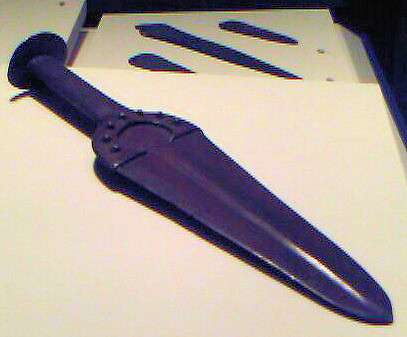
There’s also a brilliant collection of bronze age axes that are really works of art in their own right.
Then there are the pieces that really tell a tale: a chamoix sternum with bronze arrow head embedded. The arrow clearly broke thrrough bone but presumably was not fatal immediately or the hunter would have recovered the no doubt valuable arrowhead.
Then you are into the art. I was perhaps most taken by the piece of fun at the top of the stairs:
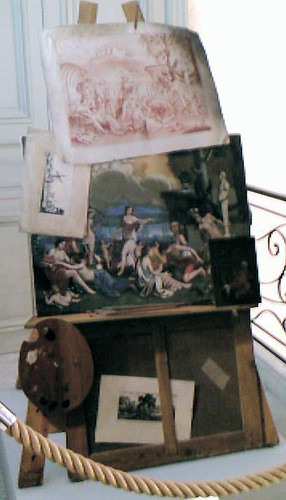
Ah ha, you say, a piece of post-modern fun. No, a piece of fun from 1686 by Antonio Forbera which shows the city’s still-evident taste for trompe d’oeil. This is apparently an artist’s stand; the palette hangs off, brushes rest on shelf in front of completed painting with a couple of sketches around it. But it is all actually a flat timber and canvas cut to the appropriate shapes.
Then there’s a quick swoop through the centuries, including:
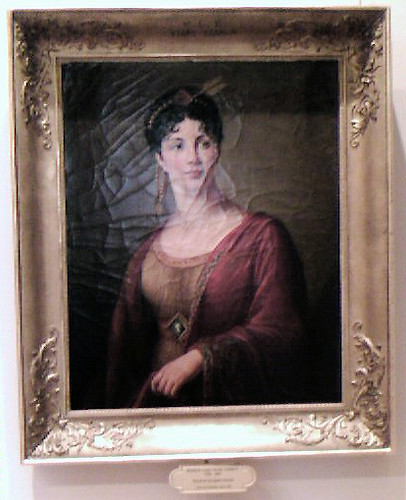
A portrait of Giuseppina Grassini by Vigee-Lebrun.
Showing until March 5 within the museum (and included in the entry charge) is The Masters of the North exhibition.
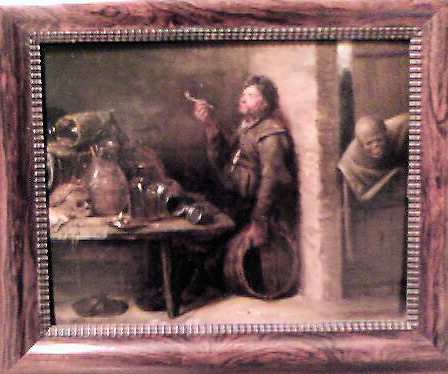
My favourite piece was definitely this dark littlle Joos van craesbreeck Le Fumeur et La Mort. It shows a smoker sitting on an unstable-looking barrel. He’s gazing blankly into the distance while a ghostly sketal death glides through the door. There’s a skull on the table with rich-looking gold painted glass vessels broken and draped with straw.
When these artists went out to deliver a moral message they really delivered it!
But after the melancholy of the 16th century, the 17th got more cheerful as epitomised by Michael van Musschler’s La Lecon de Luth Interrompue. There’s a wealth of possibility in glance between teacher and attractive, richly clad female student as he pours her a glass of wine. A rich tapestry rug lies tumbled on the table and a longhaired spaniel lies asleep at her feet (so that old symbolism hasn’t disappeared.
But there is nothing negative in the portrayal these are rich bourgeoises who know exactly what they are doing and are going to enjoy it without a hangover in the morning.
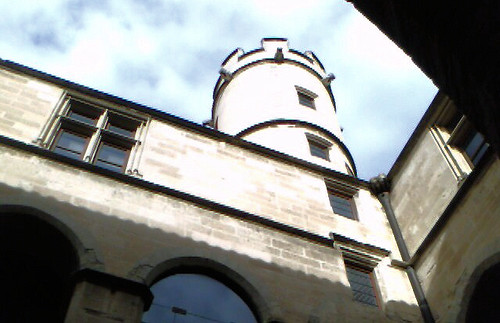

 About
About